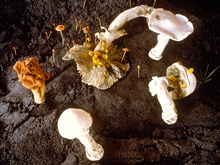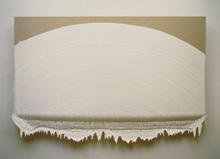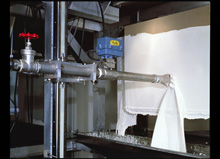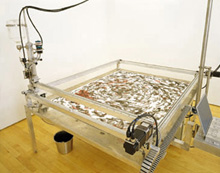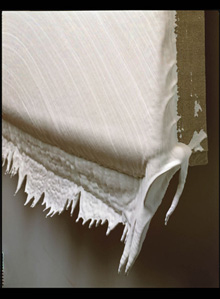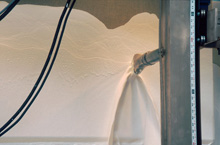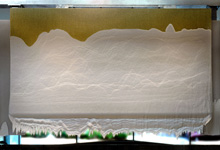Roxy Paine
June 29 - August 11, 2001
Life is found in animals and plants; but while in animals it is clearly manifest, in plants it is hidden and not evident. For before we can assert the presence of life in plants, a long inquiry must be held as to whether plants possess a soul and a distinguishing capacity for pleasure and pain.-Aristotle, On Plants.
Addiction creates a god so that time will stop.-Ann Marlowe, How to stop time: heroin from A to Z.
As botanical research proceeds, science will confirm what junkies have known all along: plants have speeds far different, and more vegetal than our own. Cocteau noted that “opium is the only vegetable substance which communicates the vegetable state to us.” Lower on the ecological ladder than plants, the phylum of fungi operate at even slower speeds: the lugubrious, controlled rate at which they decompose the two other members of the natural world after they have died: the plants or producers, who supply their own food, and the consumers or animals, who eat the food made by others. Roxy Paine’s two newest machines are producers. Painting Manufacture Unit (PMU) and Drawing Machine offer a primer on the super slow speeds of being under the influence of highly controlled or mediated substances: high grade acrylic paint as it cascades down a canvas or is sprayed out of a nozzle onto a flat bed of drawing paper. And beyond those pre-meditated speeds at which paint accumulates and dries on various surfaces, there are speeds of other controlled substances like metal, like opium and junk, like automated machines punching through production codes, like the rate of information oscillating on a computer panel, like amphetamines and coke, like geologic time, like time on an assembly line, like time on drugs-in particular opiates and hallucinogens, each - with their own specific velocities. Burroughs noted in The Naked Lunch, “delay is a rule in the junk business. The Man is never on time.” Paine’s machines put the idea of efficient labor to sleep. All these various time frames, perceptual flows of imagery, the ebb and flow of being high, Burroughs’ “algebra of need,” the intake and outtake of data and painting respectively, all these numbers and chronological starting points, all of these geo-crystalline formations congeal on one allegorical vista: the time, at once mechanical, geologic and vegetal, it takes to make a painting.
Turning rapid and efficient production (i.e. labor) on its head, both the PMU and the Drawing Machine are labor-intensive machines that take their time, as if riffing on junk. In a bit of perverse logic, they could be said to almost enjoy such mind-numbing work. Of course, they take weeks, not days, to produce a finished commodity. Both machines grow out of earlier projects, including the SCUMAK and Paint Dipper. One of his first art-making machines, the Paint Dipper, periodically dipped a canvas into a reservoir of paint, thereby creating paintings whose bottom edge had congealed into what looked like a series of stalactites. In SCUMAK a series of biomorphic sculptures were churned out in a leisurely process that took up to 8 hours. Although both of Paine’s newer art-making machines are fully automated, they are run by computers which Paine has programmed. In this sense, the machines do not create works of art; they merely carry out orders in a manner that is lackadaisical, languorous and rigidly scripted. When a work is finished, Paine plugs in another set of paint parameters, and the languorous cycle begins anew. In PMU, a spray nozzle mounted on a large moving arm travels in front of a canvas, spraying paint as it makes its pass. Like the rigid barrier that emerged sometime late in the Victorian era between leisure and The Job, each step of the art-making process is rigidly demarcated. After a programmed amount of inactivity, which allows the paint to dry, the arm gets to work again and makes another pass. In the unceasing process of working and resting, the simulacrum of a workweek plays itself out, a painting is slowly built up out of laboring, and a distinctly residual layer (reminiscent of geological strata) is deposited as the addendum to a post-euphoric moment. The blissed out or bored machine, who can tell, makes anywhere from between 80 and 200 passes-depending on the size of the canvas and thickness of the paint surface desired. Time seems to stand still. With Drawing Machine, a similar procedure occurs, only in this case, the canvas is a piece of paper mounted to an aluminum board (to prevent curling of the paper). The machine floods paint into a mixing chamber, swirls the paint around, and then dispenses it via a spray nozzle that travels a pre-programmed course over the paper. After making its pass and releasing its paint load, the machine rests, allowing the paint to dry-before another pass is made. In this way, these machines are subservient not only to the computer programmer but also to the time i.e. the natural process whereby paint dries.
In Paine’s art-making machines, the vegetal sections of the brain are thus married to a computer’s time clock. Even the early works are executed as lapsed chronological pieces. Each painting created by Paint Dipper, a machine that methodically dips a canvas into a vat of paint, was titled according to the time of day it was started. Painting 23165231997A, for example, began at 11:16 PM on May 23, 1997. Similarly, Crop, a meticulously crafted arrangement of poppies, orchestrates poppies through all stages of their life cycles, including the slitting of the pod and the eventual harvesting of the latex opium that slowly oozes out. Paine’s most recent works are no less rigidly programmed to control the exact amount of paint, the colors, and the speed of delivery. There is no accident about the dosing, which establishes a mathematical or crystalline equation between an act (of labor) and its hallucination (the commodity). What is a painting or sculpture for Paine? The labor + time expended while producing something, time that knows no calendrical bounds, that transcends boredom and desire simultaneously, and hence is the most toxic substance around. Baudelaire, speaking of hashish: “One lives several lifetimes in the space of an hour.” More specifically, it is the time it takes for an artwork a.k.a. vision or hallucination to appear ‘out of nowhere.’ The rate at which hallucinations appear is never entirely predictable, just as no drug trip is exactly like any other. Paine’s works are one-of-a kind products of physics and chemistry-and the randomness that punctuates both mechanical processes and nature. What happens when we hallucinate? Can being on drugs be subsumed to a theory of labor? In Paine’s works technology resembles nature, which also executes production commands from innate genetic codes. Some of the SCUMAK sculptures harden a little faster than others. Some of the Drawing Machine drawings dry more slowly then others, depending on temperature, light and humidity. All labor is reified precisely because it appears naturalized within a cycle that mimics nature itself.
What is natural about Paine’s synthetic models of toxic mushrooms? Like opiates and the decomposition cycles of fungi, Paine’s machines and aesthetically synthesized landscapes create the illusion that they exist outside of mechanical, clock-driven time. Like the technology of drugs, Paine’s machines are psychoactive; they don’t merely elongate or stop time; they shift perceptions, alter moods. And they eliminate emotions such as boredom and even desire. Hallucinations are beautiful because they are produced effortlessly, and without labor. The greatest act of labor might be said to be the production of a single emotion. No one, as Burroughs noted, can be bored or distracted on junk. Being on drugs makes it unnecessary to produce those things known as feelings. As a lavish and narcissistic technology that hearkens back to an earlier era of a vivisectionist’s craft, Paine’s work-both the machines and the landscapes-produces nostalgia over the end of linear time and the emotions that time generates. Such illusions are not new. Opium was popular in ancient Greece. In the Odyssey, Homer may have been referring to Plotinus’ use of it when he described “a medicine to banish grief” and the losses sustained over time.
As any addict will tell you: addiction is a form of nostalgia. Paine makes machines addicted to making paintings, to the labor of painting. He also makes hallucinatory, exquisitely unperturbed and minutely controlled replicas of mushrooms and poppies out of polymer. The mushrooms are laboriously crafted from thermoset polymer, a kind of super lightweight, synthetic clay. So, too, with his early sculpture Crop (Poppy Field 1997-98), which is akin to a botanist’s field drawing, but with a difference. Here, Paine produces a series of minute recreations of poppies that were painstakingly cast in plaster, propped up with wires, and then laboriously hand painted. The sculpture producing machine, SCUMAK, oozes work in its own time, lazily, as if doped-up (it takes up to 8 hours or one working day to produce a single sculpture). SCUMAK creates an endless series of highly pleasing and amorphous sculptural blobs. Both the art making machines and the landscapes banish the grief born of linear, chronological time; his machines, like his false fields, are meticulously calibrated to deliver something over and over and to thus deliver us to that miraculous First Time again and again.
Addiction is a surrender to a greater logic or apparatus of endless decay and renewal. Being on drugs is opposed to temporality. Fungi are not plants; they break down other organisms and thus provide for the continual rebirth of the natural world. Nature continually remakes itself. What is happiness but an illusion, which in turn is the product of immense labor, something produced on the job? The greater portion of a fungi lies underground, thus comprising an invisible and hidden system or kingdom of false production or simulation. The visible part of the fungus is merely the 'fruit' of the 'living' organism. Mushrooms, like the puffballs in Puff Ball Field (1998) are merely fruiting bodies, linked to an underlying structure (mycelium) constructed out of numerous webs or hyphae. Not content to create the illusion of a solitary mushroom, in Psilocybe Cubensis Field (1997), Paine created nearly 2200 miniature psilocybin mushrooms and affixed them to the gallery floor as if they were magically and halluciongenically sprouting out of the woodwork. In this way, Paine engineered man-made copies of a vision.
Paine’s art producing machines are custom-made to administer the precise amount of a controlled substance over time, a kind of pharmacological delivery system that injects us with a hallucination, a thing repeated, a flawed copy whose flaws are hard to see. All errors ultimately refer back to their perceiver. Paine's sculptures are elaborate plastic constructions, apparati really, as micro-genetic and highly narcissistic reproductions of desire satisfied by an outside source. Such reproductions complete the excentric circuit known as addiction. Addiction to outside work ("Business Art", Warhol called it) or addiction to the internal laws of nature, where do they overlap? Imitation at the micro-level is, as the mushroom knows, a form of reproduction in the literal sense. Paine's works reproduce themselves as lichen fields: fruits of hope. This false fruit is molded from plastic. Of course, fungi have evolved into 5 phyla, as distinct as any art school. It is frequently stated that all heroin addicts are alike. What are the bodies produced by Paine, if not the bodies of mushrooms that induce visions and the strangely anthropomorphized body of a SCUMAK or a PMU, which produce the illusion of disembodied or fully automated labor. As Cocteau noted of drug users: “They float. They vegetate in the half-light. The world remains unreal, until some substance has given it body.”
Tan Lin
New York
May 2001
Back to top

|
|




